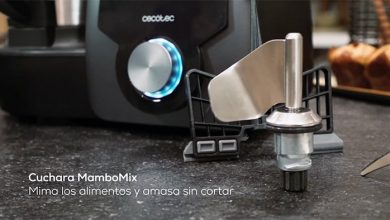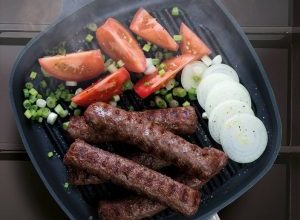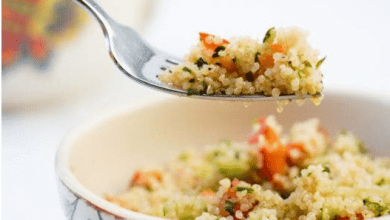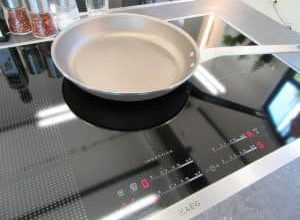Types of pans, what pan do I buy?

Pans are something that all of us who love food will have to use, but choosing among the many types of pans can seem complicated and determining which skillet is best is not always easy.
To begin with, we will have to take into account our cooking habits and how careful we are. Logically, the more we use them, the faster they will pay off and deteriorate. Therefore, when it comes to changing them, doubts come. What kind of frying pan do I buy?
Then you start looking on the internet, you enter home pages and you see that there are a million types of different pans, of different materials, different non-stick, different prices … Therefore, let’s see then the differences between a ceramic pan, Teflon, iron and titanium.
Before we start, we leave you with a table in which we have selected the three best pans out of almost 100. They are the safest, most resistant and above all, healthy. Free of PFOAS and with outstanding durability. Whichever you choose, you get it right!
TITANIUM PANS
First of all, we will start by saying that they are one of the best sellers for their non-stickiness and, above all, resistance. A few years ago, titanium pans were absolutely prohibitive for their price, but today more and more manufacturers are providing their high ranges with this precious coating at prices accessible to the vast majority of the public.
What makes them different? To begin with, we must know that when we speak of a “titanium frying pan” it is not that it is made of titanium. They are usually made of cast or forged aluminum pans, like most pans, however they owe their surname to the fact that the non-stick coating is reinforced with titanium. That is, it has a non-stick surface (like all pans) and on top of it, the Titanium layer to ensure that it does not scratch or lose qualities.
By now it is already assured that titanium makes pans safer for health. By protecting the non-stick surface, it prevents it from deteriorating and peeling off. Thus, the safety of these pans is ratified by all the quality and food safety mechanisms of the European Union.
In conclusion, these pans offer all the advantages of traditional pans, with all their non-stickness, but with a plus of outstanding resistance and durability. Therefore, they are perfect for intensive use .
ADVANTAGE:
- Strength and duration
- Healthiness and little use of oil
- Lightness
DISADVANTAGES:
- High price (although less and less)
IRON PAN
Due to its peculiarities, we have dedicated a specific entry to this type of pans ( best iron pans ). We are heavy users of iron pans; Therefore, we can guarantee that durability is assured. There are types of pans that are more resistant than others, but there are none more than iron pans.
At first it can be frustrating when all the food sticks to us, but I think it is something that is inevitable in cast iron ones without more. However, in a short time, the non-stick will come on its own and will go further. On the one hand, the frying pan will “absorb” the oil and on the other we will catch the point at the cooking temperature.
Therefore, as the pan takes on that characteristic color of our grandmothers’ pans, the non-stick will increase. Unlike the rest of the pans, with the iron ones, time and use works in our favor. A good iron skillet will last us a lifetime.
In addition, it has no toxic substances, no non-stick layers, no hypertechnological bases or anything like it. Unlike other types of pans, its simplicity lies in its resistance. As a result, the only thing that can be transferred to our food is iron, which never hurts our bodies.
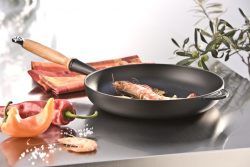
THE CHEAPEST ARE HEAVY
Unfortunately, compared to other types of pans, the weight of iron pans is especially relevant. Therefore, for people of advanced age or especially weak they are not the most suitable. For care, we must wash them by hand after each use and dry them well so that they oxidize.
However, there is a solution to these drawbacks. While conventional iron pans are very heavy and can rust if left wet, there is another type: cast iron. For example, there are models of the Le Creuset brand that have an enamel that protects them against rust. In addition, these cast iron pans are much lighter.
Bottom line: they have the advantages of an iron skillet, but without any of the disadvantages. Well, yes, it has one: its price. But we believe that it is a justified price for a frying pan that will be a regular in your kitchen for at least ten or fifteen years.
ADVANTAGE:
- Extreme resistance and durability.
- Increasing nonstickness
- Free of toxic substances
- Can add iron to food
- Metal cutlery can be used for cooking
DISADVANTAGES:
- High weight
- Initial non-stick
- May rust if left wet
TEFLON SKINS
Keep in mind that we usually associate that all pans with a non-stick surface are Teflon, although the reality is not like that. In general, there are manufacturers that decide to develop their own non-stick surface, such as the Magefesa K2 Gransasso or the Tefal Expertise.
In these cases of own surfaces, it is difficult for us to obtain references. Therefore, they can be very mediocre surfaces or excellent surfaces, such as the aforementioned Tefal Expertise.
Against this, there are firms that decide to buy the Teflon non-stick surface, which is nothing more than the commercial name of this technology. Therefore, when we buy some pans with Teflon, we can see what type of Teflon it is, if low or high range. There are several ranges: Classic, Select, Platinum Plus and Professional. Keep in mind that with each jump in the range, Teflon increases non-stick and abrasion resistance. Consequently, a skillet with a Teflon Classic finish will not be the same as one with Teflon Platinum Plus.
IF YOU BUY TEFLON, LET IT BE GOOD
Thus, it is common in these cases that the more expensive pans are usually better. However, they are always usually cheaper than titanium or cast iron. Therefore, there are countless types of Teflon pans. Consequently, we must know if it is worth investing in a pan with a Platinum Plus non-stick or not.
For example, a young man for rent who is leaving the apartment in a couple of months, maybe not. However, a family that is going to use them every day for many years, should consider buying very resistant pans. In this second case, buying some very cheap frying pans will make them available after six months and we will have wasted the money.
Here we definitely always recommend the Spanish brand BRA. It uses the highest quality Teflon and its coatings are really resistant. We have tried many and they have all come out excellent. We must confess that some BRA Terra that we have used for four years are still new.
ECONOMIC AND HEALTHY, THE MOST CHOSEN OPTION.
In addition, they are pans that, as we already talked about here, do not contain PFOAS since 2012. In our blog we talked about the safety of Teflon pans. Therefore, they are completely innocuous as long as they are not subjected to temperatures above 260º and their surface is not raised or deteriorated. We must maintain the good condition of the non-stick coating, consequently, we have to select the utensils to use well. Thus, a few steel utensils in a Teflon pan can be catastrophic. To select the most suitable kitchen utensils you can consult our blog post.
ADVANTAGE:
- Maximum non-stick
- Durability if Teflon is high-end
- Ease of cleaning
- They can be put in the dishwasher
DISADVANTAGES:
- Be careful not to scratch the Teflon
- Initial cost of some pans with Teflon Platinum Plus or Professional.
Thus, of these types of Teflon pans that we like the most are the Monix Cooper or the Bra Efficient, there are them in black and in an orange finish. The Orange ones have a more cheerful design plus and the black ones more elegant. In general, with any skillet of leading brands such as BRA or Tefal you will be right.
SEE SECTION OF TEFLON PAN
STAINLESS STEEL PAN
Let’s start with the stainless steel pans, because they are the trend in recent years. And what is the reason for its success? Well, they are robust, durable and healthy.
We live in a time when more and more people are concerned about their health and their finances. In this regard, stainless steel pans and iron pans take the cake. The difference between the two is that stainless steel pans are cheaper than the latter.
They lack chemicals that can affect our health and deteriorate, so they are especially healthy. And on the other hand, stainless steel is an excellent conductor, so they will heat up in less time and retain the heat once we turn off the fire, thereby saving energy.

SIMPLE AND DURABLE CONSTRUCTION
For its construction, only stainless steel with an alloy, generally 18/10, is used. This means that it contains 18% Chromium and 10% Nickel. This ratio is optimal and the one you can find in the best quality pans.
These pans do not have nonstick coatings or complex chemical innovations to achieve nonstick. Its own surface makes it non-stick. Of course, the oil must be hot enough or the food will stick, therefore, it requires a minimum learning period.
The only downside to these pans is the price (higher than Teflon pans) and that they weigh a little more than aluminum pans, although less than iron ones. For reference, an aluminum frying pan can weigh 1 kg, a stainless steel one 1.5 kg and an iron one 2.5 kg.
To choose a good stainless steel pan, we advise you to go to the best historical manufacturers, which are Tefal ( like Tefal Envy ) but, above all, WMF (like WMF Favorit )
ADVANTAGES OF STAINLESS STEEL:
- Extreme resistance and durability.
- Natural non-stick, without chemicals.
- Clean design and no need for any care.
DISADVANTAGES OF STAINLESS STEEL
- They are usually more expensive than Teflon pans.
- They weigh slightly more.
SEE SECTION OF STAINLESS STEEL PAN
CERAMIC PAN
First of all, say that ceramic pans are the most delicate. And it is not that they are bad (which they are not at all), but that their non-stick coating can deteriorate more easily. Therefore, when they are released, we are guaranteed a good non-stick, but we will see how if we are not careful, it will soon lose its qualities.
Also, these pans are usually cheaper than the average and can be a good option if we are aware of what we buy and we are especially careful. In addition, the non-stick coating could last a long time if we always use wooden and silicone utensils and never wash the pan in the dishwasher.
A different thing are the high-end ceramic pans, much more resistant and with outstanding non-stickiness. But as always, the price of these is quite high.
ADVANTAGE:
- Free of toxic substances
- Good non-stick with proper care.
DISADVANTAGES:
- They require being very careful, their non-stick coating is delicate.
- They are dishwasher safe but best to wash by hand with a soft sponge.
If after all you have doubts, do not hesitate to leave your comment. If you want to see all the analyzes you can do it in the upper section, where you will find complete reviews and comparisons of the best pans.
